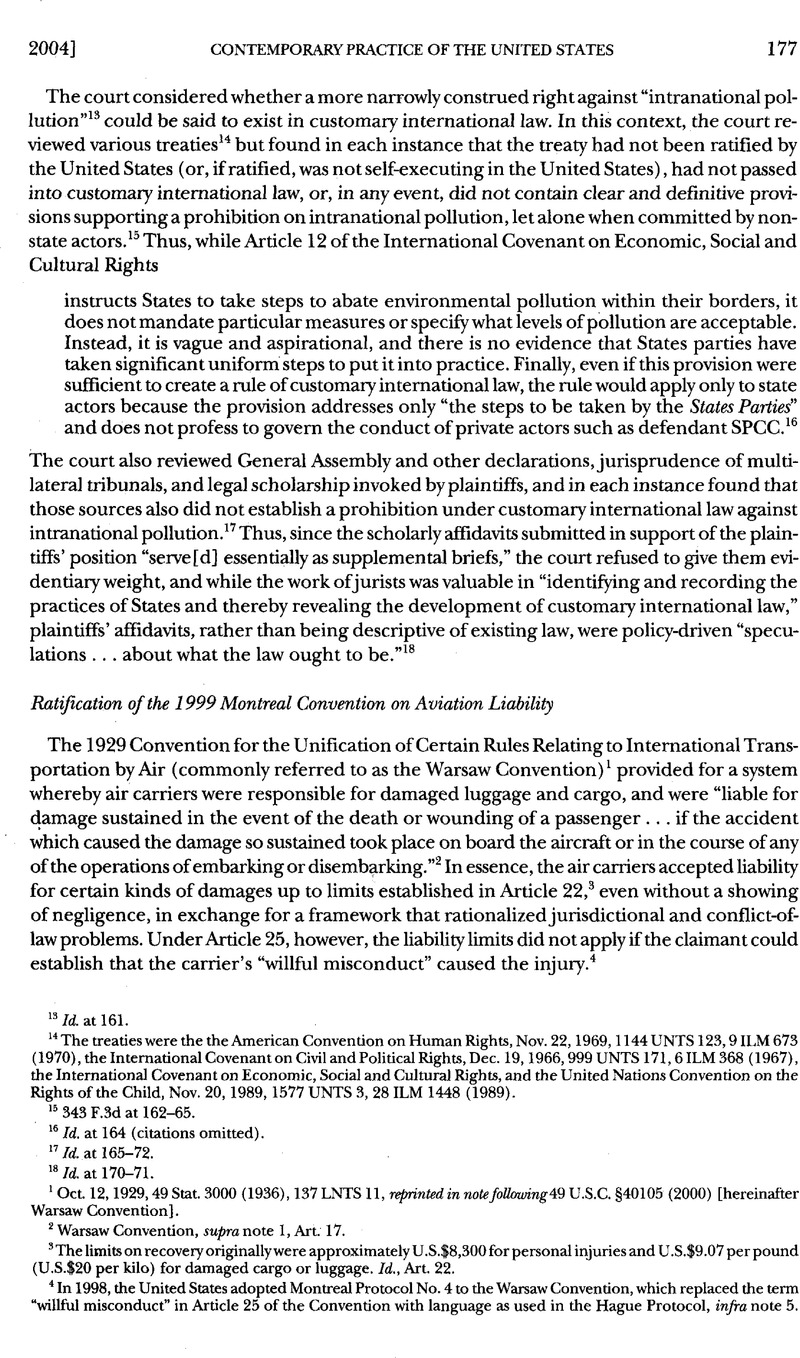Article contents
Ratification of the 1999 Montreal Convention on Aviation Liability
Published online by Cambridge University Press: 10 March 2017
Abstract

- Type
- Contemporary Practice of the United States Relating to International Law
- Information
- Copyright
- Copyright © American Society of International Law 2004
References
1 Oct. 12, 1929, 49 Stat. 3000 (1936), 137 LNTS 11, reprinted in note following 49 U.S.C. §40105 (2000) [hereinafter Warsaw Convention].
2 Warsaw Convention, supra note 1, Art. 17.
3 The limits on recovery originally were approximately U.S.$8, 300 for personal injuries and U.S.$9.07 per pound (U.S.$20 per kilo) for damaged cargo or luggage. Id., Art. 22.
4 In 1998, the United States adopted Montreal Protocol No. 4 to the Warsaw Convention, which replaced the term “willful misconduct” in Article 25 of the Convention with language as used in the Hague Protocol, infra note 5. See Montreal Protocol No. 4 to Amend the Convention for the Unification of Certain Rules Relating to International Carriage by Air, as Amended by the Protocol Done at The Hague on September 8, 1955 [hereinafter Montreal Protocol No. 4], S. EXEC. REP. No. 105-20, at 21-32 (1998).
5 Protocol to Amend the Convention for the Unification of Certain Rules Relating to International Carriage by Air, Sept. 28, 1955, 478 UNTS 371 [hereinafter Hague Protocol].
6 In Chubb & Son, Inc. v. Asiana Airlines, 214 F.3d 301, 310–13 (2d Cir. 2000), the Second Circuit held that since the United States had ratified the Warsaw Convention but had not ratified the Hague Protocol, and the Republic of Korea had ratified the Hague Protocol but had not ratified the Warsaw Convention, there were no relevant treaty relations between the United States and Korea. Consequently, die Bush administration requested in July 2002 that die Senate grant advice and consent to ratification of the Hague Protocol as a means of addressing relations with those states that are neither parties to die Warsaw Convention nor yet parties to die new 1999 Montreal Convention, infra note 8, but are party to die Hague Protocol. See Message from die President of the United States Transmitting Protocol to Amend die Convention for die Unification of Certain Rules Relating to International Carriage by Air, S.Treaty Doc. No. 107–14 (2002). The Senate granted advice and consent on July 31, 2003. See l4 Cong. Rec. S10870 (daily ed. July 31, 2003). The United States deposited its instrument of ratification on September 15, 2003, and the Protocol entered into force for the United States on December 14.
7 See Tory, A. Weigand, Accident, Exclusivity, and Passenger Disturbances Under the Warsaw Convention, 16 AM. U. Int’l L. Rev. 891, 902–10 (2001)Google Scholar.
8 Convention for die Unification of Certain Rules for International Carriage by Air, Montreal, May 28, 1999, S. Treaty Doc. No. 106–45, at 28 (2000).
9 The Special Drawing Right (SDR) is an artificial “basket” currency developed by the International Monetary Fund for internal accounting purposes. See International Monetary Fund, Special Drawing Rights (SDRs): A Factsheet (2003), at <http://www.imf.org/external/np/exr/facts/sdr.htm>>Google Scholar. The value of SDR 100, 000 is currently about U.S.$135, 000.
10 Message from the President of the United States Transmitting the Convention for the Unification of Certain Rules for International Carriage by Air, Montreal, May 28, 1999, S. TREATY Doc. No. 106-45, at X-XII (2000).
11 See 149 Cong. Reg S10870 (daily ed. July 31, 2003). For the Senate Foreign Relations Committee’s report on the convention, which concluded that no implementing legislation was required, see S. Exec. Rep. No. 108-8 (2003).
12 See U.S. Dep’t of State Press Release on Ratification of the 1999 Montreal Convention (Sept. 5, 2003), at <http://www.state.gov>.
- 2
- Cited by


